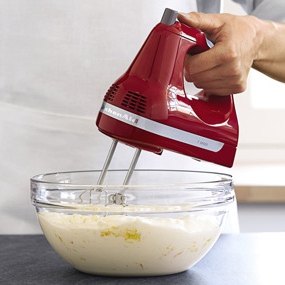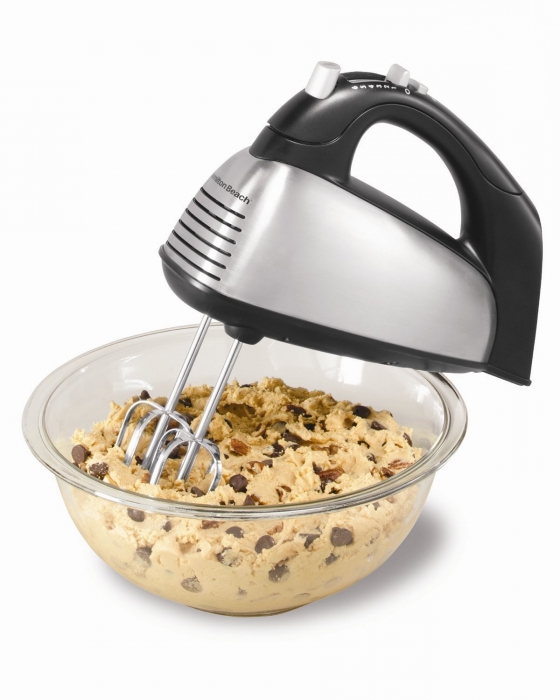A mixer is a very useful thing in the kitchen of any housewife. He can whisk, mix, and modern models - even grind products. Today on the shelves in stores there are so many mixers of different manufacturers, with various functions and capabilities, that you wondered what to choose.
Of course, I want to get a good and inexpensive model, but not everyone knows how to do it right, what to look for when buying. In this article, we will consider how to choose a mixer and not overpay for unnecessary functionality.
To begin with, we learn what mixers are, what tasks they are suitable for, what their advantages and disadvantages are.
Hand Mixer: Pros and Cons
It’s clear from the name that you always have to hold the hand mixer in your hand. Such models are lightweight, small, take up little space in the kitchen. Typically, the body of hand mixers is made of plastic and equipped with a wide convenient handle.

The advantages of a hand mixer
- Compactness.
- Easy to disassemble and clean. Typically, hand-held mixers have a button, when pressed, the nozzles themselves are removed. Keeping them clean is very simple: the corollas can be washed under water, and the case itself can only be wiped with a damp cloth.
Hand Mixer Disadvantages
- Low power, weak nozzles. Hand mixers cope only with simple tasks: beat eggs, prepare mashed potatoes, mix the dough on pancakes, but they cannot knead thick dough.
- Do not wash under water. If liquid gets inside the case, it will simply cause a breakdown. Therefore, thinking about which mixer to choose, preference should be given to models without gaps on the body.
Stationary Mixer: Pros and Cons
In stationary models, in addition to the mixer itself, there is a bowl and a stand that holds them during use. Thanks to this, hands are freed, and the hostess can do other things. Many stationary mixers spin not only nozzles, but also the stand itself, so that more uniform mixing can be achieved. Moreover, modern models work on such technology that rotation occurs in the center and along other trajectories. Stationary mixers can have two nozzles or one, but in this case it will be larger. Wide functionality makes such models more expensive than manual ones.
Before choosing a stationary type mixer, you should familiarize yourself with its pros and cons.
Advantages of the stationary mixer
- Power and strong nozzles. Unlike a manual model, a stationary mixer can handle more complex tasks. When buying, it is worthwhile to carefully examine all the nozzles for defects and how they are inserted into and removed from the case.
- Individual parts can be washed under water.
Disadvantages of the stationary mixer
Probably the one and only and most important minus of the stationary model is the large size. Therefore, it is worth considering where you will clean it until you use it.
Stationary Hand Mixer
Sometimes on sale there are so-called mixers of a mixed type, which have a stand for the mixer just as an additional component to the unit itself. Such models are convenient to use, since the excess design can be put into a drawer and use only one hand mixer, if you need to quickly beat or mix something.
Which mixer is better to choose: manual, stationary or mixed type - depends on your preferences and capabilities. Now consider the functional characteristics of all models.
Power

As already mentioned, stationary mixers have much more power than manual mixers.
The speed and quality of mixing and whipping products depends on this indicator.
If you need a mixer for making batter and creams, then an inexpensive model with a power of 150 to 300 watts will be enough.
To whip a thicker and denser dough, you need power from 250 to 350 watts. Typically, hand mixers have a power of up to 400 watts, and stationary mixers have up to 1000 watts.
Mixer speed
How much speed the mixer will have depends on power. How to choose whether you need a high-speed model or not?
To perform simple tasks, three speed modes, in principle, will be enough. These are low-power mixers. Even if such models have up to seven speeds, in fact, they will still work in three mode, since the number of revolutions will practically not change.
For powerful mixers, the speed of rotation changes markedly with each switch, even if they have up to 12 speeds.
The rotation speed can be adjusted in two ways: using the slider or by pressing the button. The latter option is not very practical, since over time the mechanism wears out, and it is inconvenient to constantly exert efforts and keep your finger on the button.
Operating modes
In modern mixers, you can find three modes of operation, each of which is designed to solve specific problems. This is normal, pulse and turbo. Let's try to figure out how to choose a mixer with a functional mode suitable for you.
- In normal mode, you can set the speed with a button or slider to whip or mix products.
- Pulse mode allows you to work with solid products. Usually it is turned on using the button. The stronger you press it, the higher the speed will develop.
- Often on mixers you can find a separate button, it activates the turbo mode, thanks to which for a short period of time the speed briefly reaches the maximum mark. Most often, this function is used in order to get rid of lumps in the test.
If you opted for a stationary model, you need to know how to choose a mixer with a bowl, since it has its own nuances.
Mixer bowl volume
This is the most important indicator in stationary models. Of course, the larger the bowl, the better, but then the mixer will take up more space. Please note that the bowl will hold about half a liter less than what is written on it, since manufacturers usually do not indicate the usable volume. And if you load the products to the brim, then splashing the contents throughout the kitchen is simply inevitable. But you do not need it?
Consider why a mixer with one volume or another is suitable:
- Bowl up to 1 liter. Usually in this case, the mixer is equipped with only nozzles for mixing and whipping. Such a small volume of the bowl is enough only for the preparation of sauce and omelet.
- Bowl from 1 to 2 liters. Typically, such a volume can be found in low-power mixers, it is already enough for kneading dough or whipping mashed potatoes. A bowl of this size is quite rare.
- Bowl from 2 to 3 liters. If you are faced with the question: “How to choose a mixer for the home?”, Then it is better to opt for such models. Bowls of this volume will be enough to carry out all the tasks that the hostess in the kitchen faces.
- Bowl from 3 liters or more. Such a volume can be found in professional powerful mixers. If cooking is not only a hobby for you, but also a way of making money, then you should pay attention to models with a large bowl. Mixers of this category are expensive, but the casing and nozzles are particularly durable, and therefore durable.
Mixer bowl material
As a rule, mixing bowls are made of two materials: plastic and metal. The latter is preferable, since it is considered more durable. But usually powerful and expensive mixers are equipped with metal bowls.
A plastic bowl is much more common in cheap and medium-priced models.It is much inferior in strength to metal, but can be made in any color. There are also transparent bowls that allow you to see to what state the products are mixed.
Mixer Options
Modern manufacturers of household appliances have come up with so many different functions and nozzles that sometimes you get lost in this variety. If you are thinking how to choose a mixer for the kitchen, then pay attention to what is included in the package, what is it used for and whether you need it at all. Otherwise, you risk overpaying for unnecessary model capabilities, and excess nozzles will gather dust in the corner.
In simple models, you can find only two pairs of nozzles - these are corollas and spirals, which are quite enough to, for example, beat eggs and knead the dough. If you purchase a more expensive hand mixer, then most likely it will include up to five nozzles. Usually this is a pair of corollas and several spirals, differing from each other in size and a little shape.

Nozzles in stationary mixers are more diverse. The package may include spirals, whisks, hooks, cutting knives, a rotating bowl. Some models are equipped with a nozzle that resembles a knife from a blender. She copes with the same tasks as her brother, - mixes sauces, turns products into mashed potatoes.
Separately, on sale you can find additional nozzles for mixers - a vegetable cutter, circular knives for potatoes, a knife for cutting meat and other useful devices.
Be sure to pay attention to the quality of manufacture of nozzles. They should not be too thin and made of wire.
What else to look for when buying a mixer
Before choosing a mixer, study the other models, what functionality they have.
Very useful compartment for storing the cord. When you take the mixer from the shelf, the wire touches other objects and pulls them along. This, to put it mildly, is not very convenient.
All mixers, even the cheapest ones, are equipped with a nozzle eject button. If this is not available, then it is worth considering whether it is worth buying such a model at all.
Mixers more expensive have more “cool” functionality: protection against overheating, clogging, the system of moving nozzles up and down. If you do not need such "bells and whistles", then you should not overpay.
Mixer Manufacturers
Of course, it is better to buy mixers from trusted manufacturers. It is not recommended to buy a model if it was made in China.
Companies such as Bosh, Siemens, Philips, Tefal, Moulinex and Vitek have established themselves as manufacturers of good products.
If you do not know which mixer to choose, it is recommended to read reviews about it before buying it. This will help you to avoid unpleasant surprises in the form of permanent breakdowns or poor-quality work of the model.
